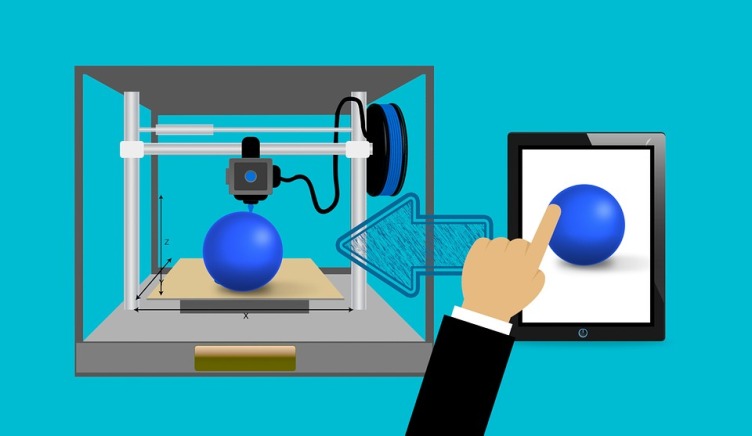3D Printers at home

September 16, 2020
Thanks to current technological advances with 3D printers you can transform your creative vision into reality and into plastic. For example you can print from human prostheses to cases for smartphones, engine parts, mechanical components, gears and many others. It is a very comfortable equipment that takes up very little space, easy to locate in any part of your home or office.
A 3D printer is a machine capable of printing graphics designs that use a three-dimensional representation of geometric data, creating volumetric parts or mockups from a computer-generated design. By volume it means that it has width, length and height.
Nowadays, 3D printers are taking more and more importance and have come to stay, and their main purpose is to revolutionize both the industry and the use of printers at home. These equipment have reached their peak in recent years, in fact many people have witnessed what can be achieved with a 3D printer as it has been the protagonist of many news headlines, especially in the field of medicine. These are used for tooling that studies and develops manufacturing techniques to obtain serial parts or prefabrication of components, in such sectors as architecture and industrial design. It is more common that of medical prostheses, where they are ideal, given the ease of adapting each part manufactured to the exact characteristics of each patient.
Diving into the sea of 3D printing is a process as exciting as it is profound. So much so, it’s easy to get overwhelmed by the vast options and possibilities available. The beginnings go beyond choosing a printer – not an easy task in terms of models, budgets and expectations – but we will also need a series of resources for learning, the use of 3D printers is very wide so we will focus on domestic use.
Raw material
The most common printing materials on a domestic scale are:
1) Acrylonitrile butadiene styrene or (ABS) is a type of resistant and hard plastic that can be sanded, polished, drilled, painted and glued. It is a very resistant filament to impact (blows) widely used in automotive and other uses both industrial as well as domestic, do LEGO pieces sound familiar to you? Exactly, they are made of this material.
2) The (PLA) filament, polylactic acid, is a thermoplastic made from renewable resources (biodegradable material) such as corn starch or sugar cane. Unlike other materials in the industry made primarily from petroleum. PLA is one of the most popular materials and the most used in the industry.
Among other materials we have high impact polystyrene, polyethylene terephthalate, Nylon, Ninjaflex.
Types of 3D Printers
Currently there are several types of 3D printers on the market, with different ranges, dimensions, accessories, supplies and costs.
There are many types of 3D printers and each one has characteristics that differentiate it from the rest:
- Extrusion of Material (FDM)
- VAT polymerization (SLA and DLP)
- Melting powder (SLS)
- Material Injection (MJ)
- Binder Injection (BJ)
- Direct Energy Deposition
- Sheet Lamination
- Currently the most used and important are; FDM, SLA and SLS.
DIY (Do It Yourself) printers are those 3D printers in which the buyer assembles and discovers the printer piece by piece. These 3D printers are sold in kit form and the user who has bought the printer must follow some assembly instructions to get printing for the first time.
The difference between (DIY) and commercial printers is as we have already explained, is that 3D printers (DIY) are printers to be assembled and unlike the so-called commercial printers. Commercial printers are those in which it is not necessary to have much knowledge technician to make them work since they practically come to plug.
Commercial 3D printers are known as Plug and Play printers, which are printers that only need to be plugged in to start enjoying them without the need for calibration or a small and simple calibration and configuration, being practically unpacking and plugging in.
Other features (Hardware)
Extruder:
The main function of the extruder is to move the filament from the coil to the HotEnd in the most precise way and at the speed suitable for 3D printing.
To begin with, we must know that the extruder is the part of the 3D printer that is pulling, dragging, catching, the filament or 3D printing material that we are using and the HotEnd that is the part that is responsible for melting it, and then depositing it in the heated bed and create our 3D printing.
What the 3D printer (Hot-Bed) does is heat the printing base to a specific temperature. What you will achieve is that the pieces adhere to the printing surface while it is hot and will peel off when it is cold.
Software
To be able to design parts that you want to print in 3D, some CAD software (computer-aided design) is required, of which we can mention:
- Blender
- DraftSight
- Catia
- FreeCAD
- OpenSCAD
- SolidWorks
- Tinkercad
- AutoCAD
- Cinema4D
Many of these programs are very easy to use, since the interfaces are very pleasant for the user, and some of them also present us with special tools to be able to know if our design meets the expected characteristics in terms of both form and performance.
Websites, STL file banks, virtual marketplaces and search engines to download 3D models for printing
3D printing is done in a digital file. This file, usually in STL format, is transmitted to the 3D printer and laminated in several layers by a second software called a slicer or laminator. After this, the machine can continue with the printing process. Therefore, STL files are essential to get started and many platforms have specialized in downloading these files. They collect thousands of 3D models (free and paid), and allow the community to share their projects easily.
Here some of the best portals:
1. Cults
2. Free3D
3. GrabCAD
4. MyMiniFactory
5. Thingiverse
3D printers have given inventors, designers and artists the ability to imagine something in their head and have it physically in a matter of hours. With the exponential growth of free designs and the expansion of 3D printing, enormous individual potential wealth is being generated. The fields of application are innumerable, although they are probably not really practical for most home users who, beyond satisfying their personal curiosity, may not take advantage of the full potential of this product, but designers, 3D artists, architects, doctors, modelers, machinists, criminalists and many other professions will find in this a product that requires minimal maintenance and that will allow them to obtain excellent results at a very attractive price.








